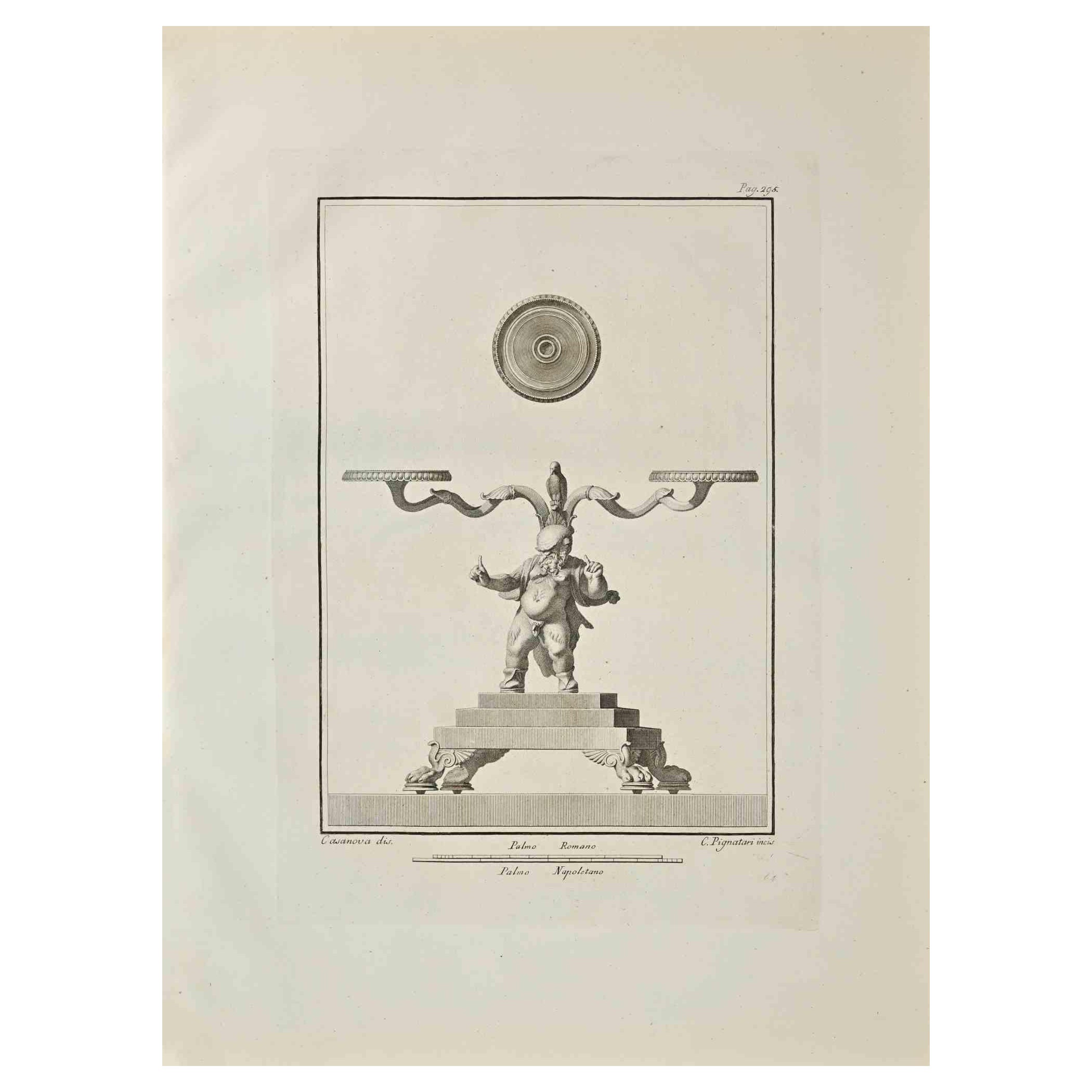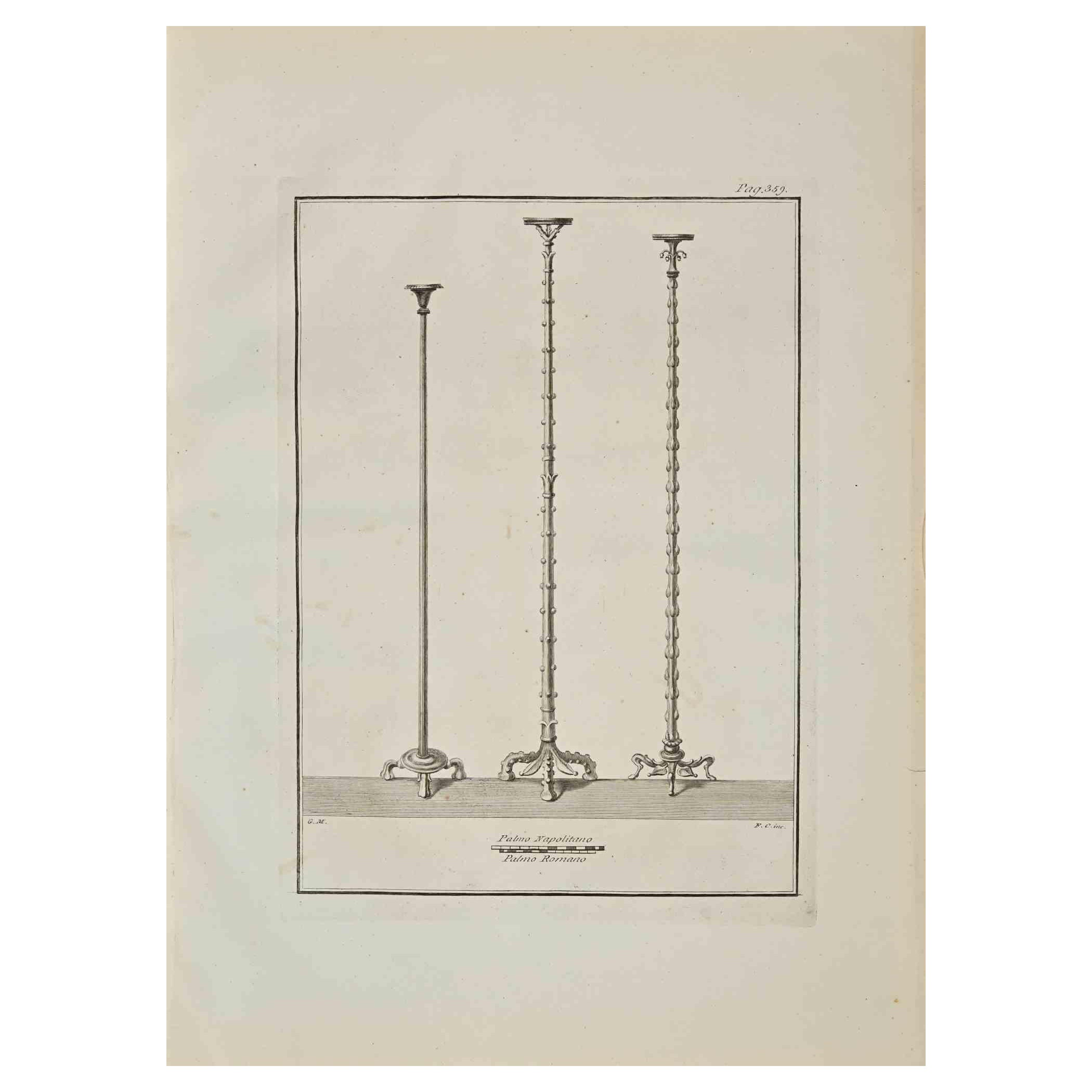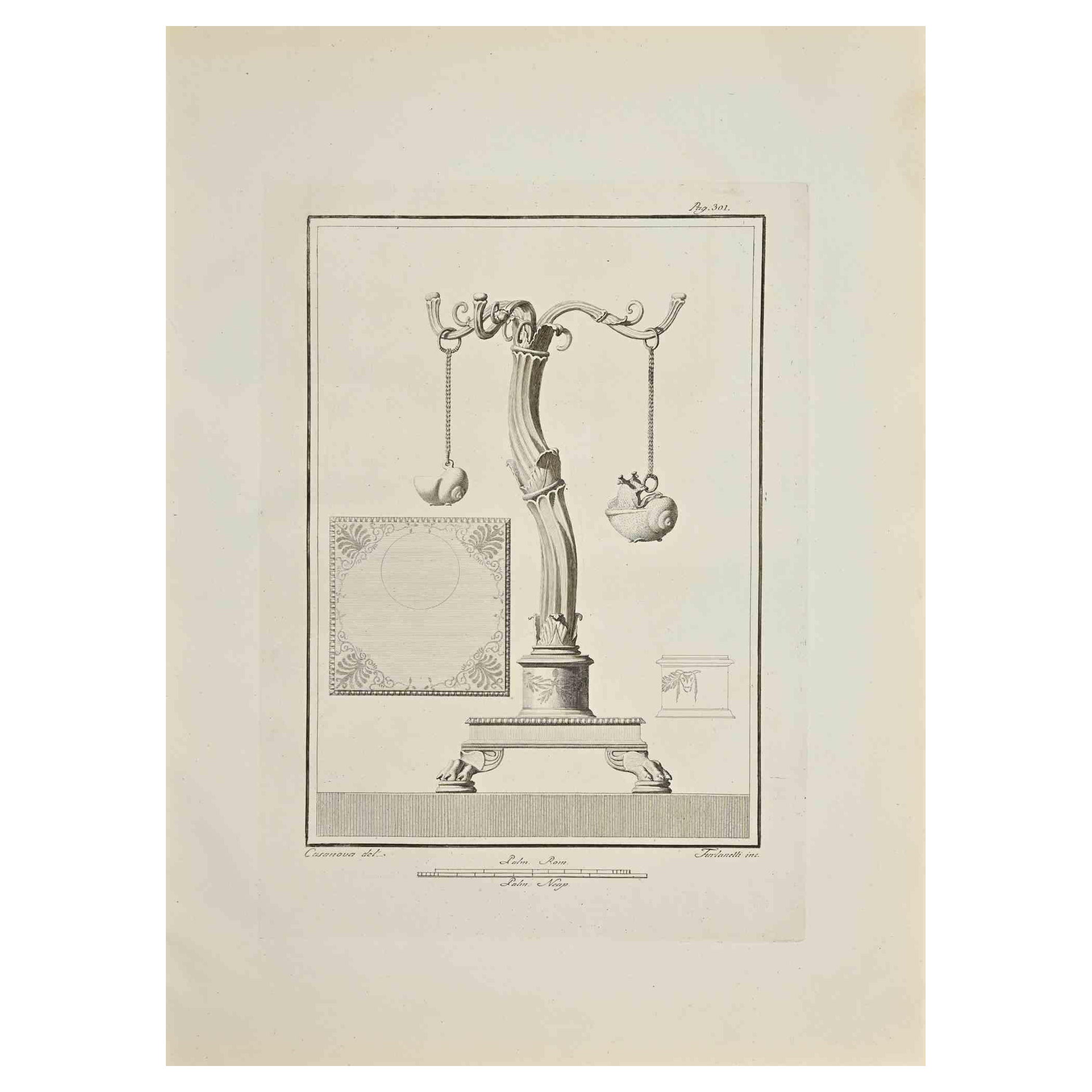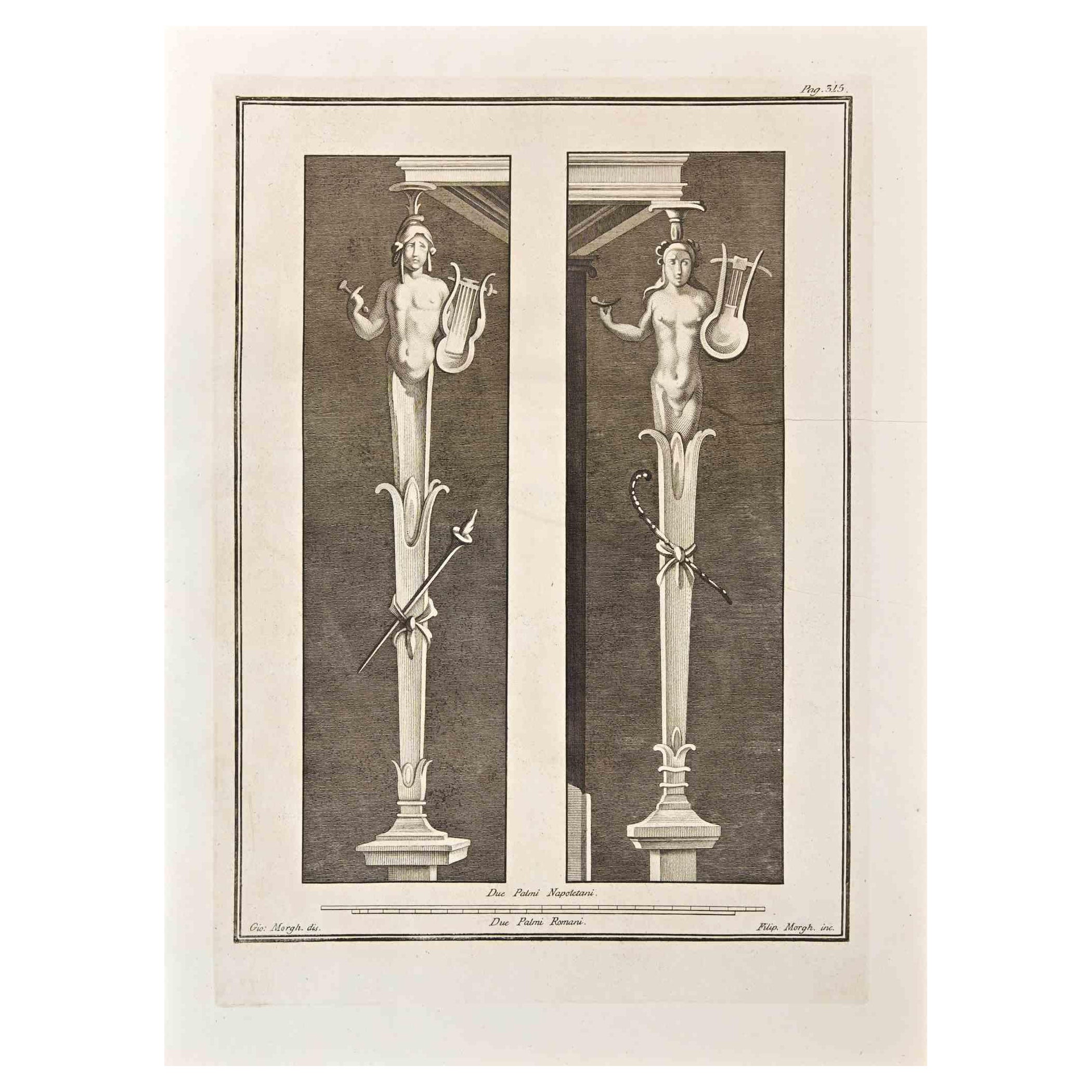Items Similar to Apollo God With his Lyre - Etching by Pietro Campana - 18th Century
Want more images or videos?
Request additional images or videos from the seller
1 of 5
Pietro CampanaApollo God With his Lyre - Etching by Pietro Campana - 18th CenturyLate 18th Century
Late 18th Century
About the Item
Apollo God With his Lyre from "Antiquities of Herculaneum" is an etching on paper realized by Pietro Campana in the 18th Century.
Signed on the plate.
Good conditions with aged margins and some folding.
The etching belongs to the print suite “Antiquities of Herculaneum Exposed” (original title: “Le Antichità di Ercolano Esposte”), an eight-volume volume of engravings of the finds from the excavation of the ruins of Herculaneum in the Kingdom of Naples (now Campania, Italy).
It was published between 1757 and 1792 by the Regia Stamperia, and copies were delivered to selected recipients across Europe.
Despite the title, the Antiquity of Herculaneum shows objects from all the excavations undertaken by the Bourbons in the Gulf of Naples. These include Pompeii, Stabia and two sites of Herculaneum: Resina and Portici.
The Bourbon King Carlo appointed fifteen scholars creating a new “Herculaneum Academy” to study the artifacts and publish the results of the archaeological excavations of the sites.
The engravings are of high quality and the accompanying text shows a large scholarship.
They were realized by 25 prominent artists involved by the King to prepare drawings and engravings on the finds, among which we can find Giovanni Elia Morghen, Carlo Nolli, Luigi Vanvitelli, and Giovanni Battista Casanova.
The “Antiquities” was designed more to amaze readers with the quality of the objects in the collection of the King of Naples than to be used in research., following and increasing the interest of 18th-century society for the classical culture and Art in particular.
Through the exaltation of the classical concept of proportions and harmony, the book was of inspiration to the neoclassical movement in Europe, giving artists and decorators access to a huge shop of Hellenistic motifs.
- Creator:Pietro Campana (1727 - 1765, Spanish)
- Creation Year:Late 18th Century
- Dimensions:Height: 19.69 in (50 cm)Width: 14.18 in (36 cm)Depth: 0.04 in (1 mm)
- Medium:
- Movement & Style:
- Period:
- Framing:Framing Options Available
- Condition:Insurance may be requested by customers as additional service, contact us for more information.
- Gallery Location:Roma, IT
- Reference Number:Seller: T-1367101stDibs: LU650311611292
About the Seller
4.9
Platinum Seller
These expertly vetted sellers are 1stDibs' most experienced sellers and are rated highest by our customers.
1stDibs seller since 2017
6,746 sales on 1stDibs
Typical response time: 2 hours
- ShippingRetrieving quote...Ships From: Grasse, France
- Return PolicyA return for this item may be initiated within 14 days of delivery.
Auctions on 1stDibs
Our timed auctions are an opportunity to bid on extraordinary design. We do not charge a Buyer's Premium and shipping is facilitated by 1stDibs and/or the seller. Plus, all auction purchases are covered by our comprehensive Buyer Protection. Learn More
More From This SellerView All
- The Family - Original Etching by Jean-Louis Demarne - 18th centuryLocated in Roma, ITThe Family is an Original Etching realized by Jean-Louis Demarne (1744-1829). The little artwork is in good condition, included a light green cardboard passpartout (49x31.5 cm). Stamp signed on the lower right corner. Jean-Louis de Marne (1752-24 March 1829) was a French painter. He concentrated on landscape and genre painting, in which he was greatly influenced by such 17th century Dutch masters as Aelbert Cuyp...Category
18th Century Old Masters Figurative Prints
MaterialsEtching
- Ancient Roman Fresco - Original Etching By F. Cepparuli - Mid-18th CenturyBy Francesco CepparuliLocated in Roma, ITFrancesco Cepparuli, Ancient Roman Fresco, original etching hand watercolored. Mid-18th Century. original etching from the end of the 18th century, realized by Francesco Cepparuli. ...Category
Late 18th Century Old Masters Figurative Prints
MaterialsEtching
- Chiesa di S. Paolo alle Tre Fontane - Etching by G. Vasi - Late 18th CenturyBy Giuseppe VasiLocated in Roma, ITChiesa di S. Paolo alle Tre Fontane is an original black and white etching of the Late 18th century realized by Giuseppe Vasi. The beautiful etching represents a glimpse of Rome. S...Category
Late 18th Century Old Masters Figurative Prints
MaterialsEtching
- Chiesa della SS. Trinità - Etching by G. Vasi - Late 18th CenturyBy Giuseppe VasiLocated in Roma, ITChiesa della SS. Trinità is a black and white etching of the Late 18th century realized by Giuseppe Vasi. Signed and titled on plate lower margin. Good conditions and aged margins...Category
Late 18th Century Old Masters Figurative Prints
MaterialsEtching
- Tempio della Fortuna - Etching by G. Vasi - Late 18th CenturyBy Giuseppe VasiLocated in Roma, ITTempio della Fortuna is an original etching hand watercolored of the Late 18th century realized by Giuseppe Vasi. Signed and titled on plate lower margin. Good conditions and aged...Category
Late 18th Century Old Masters Figurative Prints
MaterialsEtching
- Chiesa di Paolo Primo Eremita - Etching by G. Vasi - Late 18th CenturyBy Giuseppe VasiLocated in Roma, ITChiesa di Paolo Primo Eremita is an original black and white etching of the Late 18th century realized by Giuseppe Vasi. Signed and titled on plate lower mar...Category
Late 18th Century Old Masters Figurative Prints
MaterialsEtching
You May Also Like
- Basilica of San Lorenzo in Rome: A Framed 18th Century Etching by PiranesiBy Giovanni Battista PiranesiLocated in Alamo, CAThis large framed 18th century etching by Giovanni Battista Piranesi entitled "Veduta della Basilica di S. Lorenzo fuor della mura" (Basilica of San Lorenzo Outside the Walls), published in Rome in 1750 in Piranesi's Vedute di Roma (Views of Rome), This etching depicts the Basilica of San Lorenzo Outside the Walls, which is a Roman Catholic papal basilica and parish church, located in Rome, Italy. The Basilica is one of the Seven Pilgrim Churches of Rome and one of the five "papal basilicas". It was built as a shrine to the martyred Roman deacon St. Lawrence. This Piranesi etching is held by many museums and institutions, including: The Metropolitan Museum, The British Museum, The National Gallery of Art, The Yale University Art Gallery, and The Harvard Museum of Art. This magnificent etching is presented in a brown-colored wood frame and a tan French...Category
1750s Old Masters Landscape Prints
MaterialsEtching
- Ruins of the Roman Baths of Belisarius: A 19th C. Etching by Luigi RossiniBy Luigi RossiniLocated in Alamo, CAThis early 19th century etching entitled "Veduta degl' Avanzi delle Torri di Belisario Dalla parte che guarda l' Interno della Città, vicino a Porta S. Giovanni, A. Mura Aureliane" (...Category
1820s Old Masters Landscape Prints
MaterialsEtching
- Church of St. Costanza, Rome: An 18th Century Piranesi Architectural EtchingBy Giovanni Battista PiranesiLocated in Alamo, CAThis is a framed 18th century Giovanni Battista Piranesi etching entitled: "Veduta interna del Sepocro di Santa Costanza, fabbricat...Category
1770s Old Masters Interior Prints
MaterialsEtching
- Crucifixion: 18th Century Etching by Conrad Metz after Daniele da VolterraLocated in Alamo, CA"Crucifixion" is an etching and aquatint, printed in brown ink by Conrad M. Metz after a painting by Daniele da Volterra. It was published in London in 1789 in 'Imitations Of Ancient...Category
Late 18th Century Old Masters Figurative Prints
MaterialsEtching, Aquatint
- Fabricius (Ponte Cestio) Bridge : Framed 18th C. Piranesi Architectural EtchingBy Giovanni Battista PiranesiLocated in Alamo, CAThis framed 18th century etching by Giovanni Battista Piranesi is entitled "Dimostransi nella Tav. presente la Pianta, ed Elevazione del Ponte, oggi detto Quattro Capi egli è antichissimo, e chiamavasi Fabrizio da L. Fabrizio Presid. delle Strade, che lo fabbrico' nel fine della Repubblica. "(The Plan and Elevation of the Bridge, today called Quattro Capi. The architect is very ancient, and was called Fabrizio da L. Fabrizio Presid. delle Strade, who built it at the end of the Republic). This is plate 18 in volume 4 of Piranesi's "Le antichita romane opera di Giambatista Piranesi architetto veneziano" (Roman antiquities by Giambatista Piranesi Venetian architect). It was published in Rome in 1756-1757. This etching depicts the plan and elevation of the bridge now called the Ponte dei Quattoro Capi or Ponte Cestio (Bridge of the Four Heads), which in antiquity was called the Bridge of Fabricius after L. Fabricius, the Superintendant of the Streets who built it at the end of the Republic, around 62 BC. It was also been known in the Middle Ages as ‘Ponte Giudeo’ (Bridge of the Jews). The bridge crossed from the left bank or northeast side of the Tiber River to Tiber Island...Category
1750s Old Masters Landscape Prints
MaterialsEtching
- Column of Trajan in Rome: A Framed Original 19th C. Etching by Luigi RossiniBy Luigi RossiniLocated in Alamo, CAThis early 19th century etching entitled "Veduta dello scavo del Foro Trajano" was created by Luigi Rossini and included in his publication "Le Antichita Romane" (The Rome of Antiquity), published in Rome in 1823. It depicts the historical victory column of Trajan standing amidst the rubble of broken columns that remain around it. The etching is presented in a black wood frame with a light brown outer mat and a dark brown inner mat. There are several frame abrasions. The print and mats are in very good condition. The frame measures 27" high, 29.07" wide and 0.5" deep. The print is framed and matted in the identical style as the another etching of an ancient Roman landmark, the Piazza Navona, which is also listed on 1stdibs, see item # LU117326144172. The pair would make an attractive display grouping of Roman architecture. A discount is available for purchase of the pair of prints. Luigi Rossini (1790-1857) like his predecessors, Giovanni Piranesi (1720–1778) and Giuseppi Vasi (1710-1782), was an architect and artist. Like Piranesi and Vasi, he wanted to glorify the architecture of ancient Rome, which he felt was deteriorating and needed to be documented. Several of the ruins he illustrated have, in fact, since disappeared leaving only his images as a record of their appearance. His images of the grand edifices of the city dramatically depict the power and glory...Category
1820s Old Masters Figurative Prints
MaterialsEtching
Recently Viewed
View AllMore Ways To Browse
Antique God
Apollo Antique
Signed Apollo
Apollo Print
18th Century Lyre
Apollo God
Master Apollo
Pietro Campana
Mexico Lithograph
Andy Warhol Keith
Statue Print
Retro War Posters Art Posters
Pablo Picasso Cubism
Retro La Posters
Peter Max Artist
Marc Chagal Original
Dali Signed And Numbered Print
Black And White Engraving





